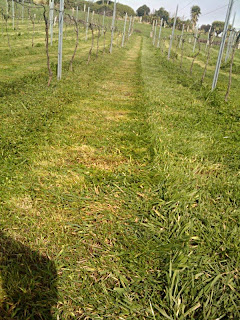Saw this article today, courtesy TizWine:
http://www.decanter.com/news/wine-news/499095/first-tasting-of-lost-grapes-in-southwest-france
It's nice to see that just because some varieties are not in vogue at the moment, people aren't necessarily discounting their worth!
It was not that long ago that Viognier was almost grubbed out of existence, with sources commonly stating that there were as little as eight acres of the variety left in France in the mid 60s. Now it is enjoying a renaissance with the New World wine countries, including New Zealand, experimenting with the grape and becoming quite successful...
Lesser-known varieties such as Sauvignon gris and Arneis are getting a mainstream chance, with reasonably large bottlings going on and being made available commercially (via Pernod-Ricard NZ Sauvignon gris and Arneis and Forrest Estate Arneis, respectively, to name a few -both varieties are worth trying - I've had the P-R Sauv gris and the Forrest Arneis).
So kudos to those around the world that are not following the wave and replacing all of the world's grape diversity with seas of Cabernet Sauvignon and Chardonnay!
And to complete the circle, a thank you to all of you who go out and try a bottle of all these lesser known varieties! Unless it's sold and tried, we may lose some of these cultivars forever!
NB:
For an excellent resource on varietal names, have a look at the Super Gigantic Winegrape Glossary, which was put together by Anthony J. Hawkins. Sometimes entries are very detailed, but at the least, there's some interesting information in there!
Monday, September 13, 2010
Tuesday, September 7, 2010
How low is low enough?
First of all, let me say how lucky I feel for my family and home to have made it through the Christchurch earthquake with so little effect - my best wishes go to those that were not so fortunate!
However, despite the 7.1 magnitude earthquake, the vines continue developing! And about 10 hours after it hit, we were out in the vineyard, finishing up the pruning! This because we're on a pretty warm site for Canterbury, and the buds were showing signs of pushing, making it more difficult to prune. At this stage, the buds start getting more susceptible to being rubbed off, so pulling brush can be a very time-consuming affair if they get too far along!
So once that was finished, I could put on a lime-sulfur spray, which should help control any carryover powdery mildew that could have been left as dormant hyphae on canes left for the coming season.
Then came the job of getting ready for spring frosts! This takes the form of mowing the cover crop as closely as possible, so that as much solar energy as possible can be absorbed during the day, and the also released at night. A higher growing cover crop can insulate the soil from gathering the sun's energy during the day, and also keep it from radiating that heat at night, causing an increased frost risk.
So as the grass was relatively high, I had to do a first pass, and then another cut with the mower.
So we're still a ways away from budbreak (meaning green tissue visible on the buds), and therefore the most sensitive time for the shoots to freezing temperature, but even now they are starting to be more susceptible to frosts. I will be keeping the grass as short as possible over the next few months!!
However, despite the 7.1 magnitude earthquake, the vines continue developing! And about 10 hours after it hit, we were out in the vineyard, finishing up the pruning! This because we're on a pretty warm site for Canterbury, and the buds were showing signs of pushing, making it more difficult to prune. At this stage, the buds start getting more susceptible to being rubbed off, so pulling brush can be a very time-consuming affair if they get too far along!
So once that was finished, I could put on a lime-sulfur spray, which should help control any carryover powdery mildew that could have been left as dormant hyphae on canes left for the coming season.
Powdery mildew infections on dormant canes - the dark blotches are areas where the fungal hyphae have gotten into the shoot tissue during the season
Then came the job of getting ready for spring frosts! This takes the form of mowing the cover crop as closely as possible, so that as much solar energy as possible can be absorbed during the day, and the also released at night. A higher growing cover crop can insulate the soil from gathering the sun's energy during the day, and also keep it from radiating that heat at night, causing an increased frost risk.
So as the grass was relatively high, I had to do a first pass, and then another cut with the mower.
Closeup of the first (upper third) and second pass (lower two-thirds) of the mower. You can see that I've cut the grass shorter than it's been in a while as it's more yellow than the grass in the background.
A longer view of the row (sorry for the "Batman" angle!). First pass on the right, and second on the left.
So we're still a ways away from budbreak (meaning green tissue visible on the buds), and therefore the most sensitive time for the shoots to freezing temperature, but even now they are starting to be more susceptible to frosts. I will be keeping the grass as short as possible over the next few months!!
Subscribe to:
Posts (Atom)


